Assessing the Impacts of Climate Change on River Discharge Dynamics in Oueme River Basin (Benin, West Africa)
Abstract
:1. Introduction
2. Study Areas and Methodology
2.1. Characteristics the Study Areas
2.2. Methodology
2.2.1. Observed and Regional Climate Models (RCM) Data Used
2.2.2. Bias Correction
2.2.3. Hydrological Modelling
3. Results and Discussion
3.1. Evaluation of the DBS Bias Correction
3.2. Projected River Discharge Based on HyMoLAP
3.2.1. Simulation of River Discharge with HyMoLAP
3.2.2. Changes of Average Hydrograph
3.2.3. Uncertainty in River Discharge Projections
3.3. Discussion
4. Conclusions
Acknowledgments
Conflicts of Interest
References
- Christensen, J.H.; Hewitson, B.; Busuioc, A.; Chen, A.; Gao, X.; Held, R.; Jones, R.; Kolli, R.K.; Kwon, W.K.; Laprise, R.; et al. Regional climate projections. In Climate Change 2007: The Physical Science Basis; Contribution of Working Group I to the Fourth Assessment Report of the Intergovernmental Panel on Climate Change; Solomon, S., Qin, D., Manning, M., Chen, Z., Marquis, M., Averyt, K.B., Tignor, M., Miller, H.L., Eds.; Cambridge University Press: Cambridge, UK; New York, NY, USA, 2007. [Google Scholar]
- Sillmann, J.; Roeckner, E. Indices for extreme events in projections of anthropogenic climate change. Clim. Chang. 2008, 86, 83–104. [Google Scholar] [CrossRef]
- Van Dam, J.C. Impacts of Climate Change and Climatic Variability on Hydrological Regimes; International Hydrology Series; Cambridge University Press: Cambridge, UK, 1999. [Google Scholar]
- Intergovernmental Panel on Climate Change (IPCC). Climate Change: Impacts, Adaptation, and Vulnerability: Part A: Global and Sectoral Aspects; Contribution of Working Group II to the Fifth Assessment Report of the Intergovernmental Panel on Climate Change; Field, C.B., Barros, V.R., Dokken, D.J., Mach, K.J., Mastrandrea, M.D., Bilir, T.E., Chatterjee, M., Ebi, K.L., Estrada, Y.O., Genova, R.C., et al., Eds.; Cambridge University Press: Cambridge, UK; New York, NY, USA, 2014. [Google Scholar]
- Kundzewicz, Z.W.; Kanae, S.; Seneviratne, S.I.; Handmer, J.; Nicholls, N.; Peduzzi, P.; Mechler, R.; Bouwer, L.M.; Arnell, N.; Mach, K.; et al. Flood risk and climate change: Global and regional perspectives. Hydrol. Sci. J. 2014, 59, 1–28. [Google Scholar] [CrossRef]
- Khatri, K.B. Risk and Uncertainty Analysis for Sustainable Urban Water Systems. Ph.D. Thesis, UNESCO-IHE Delft Institute for Water Education, Delft, The Netherlands, 2013. [Google Scholar]
- Afouda, A.; Ould Baba Sy, M.; Gaye, A.T.; Cabral, A.; Nazoumou, Y.; Compaore, A.J.; Sanoussi, R. Impact of Climate Change and Variability on Water Resources in West African Watersheds: What Are the Prospects? Synthesis Report-Writeshop: Dakar, Senegal, 2007. [Google Scholar]
- World Bank. Inondations au Benin: Rapport d’Evaluation des Besoins Post Catastrophe; World Bank: Washington, DC, USA, 2011. [Google Scholar]
- Barrios, S.; Ouattara, B.; Strobl, E. The impact of climatic change on agricultural production: Is it different for Africa? Food Policy 2008, 33, 287–298. [Google Scholar] [CrossRef] [Green Version]
- Dang, H.; Gillett, N.P.; Weaver, A.J.; Zwiers, F.W. Climate change detection over different land surface vegetation classes. Int. J. Climatol. 2007, 27, 211–220. [Google Scholar] [CrossRef]
- Intergovmmental Panel on Climate Change (IPCC). Climate Change: The Climate Change; Contribution of the Working Group I to the third Asseesment Report of the Intergovmmental Panel on Climate Change; Cambridge University Press: Cambridge, UK, 2001. [Google Scholar]
- Meissner, K.; Weaver, A.; Matthews, H.; Cox, P. The role of land surface dynamics in glacial inception: A study with the UVic, Earth System Model. Clim. Dyn. 2003, 21, 515–537. [Google Scholar] [CrossRef]
- Snyder, P.; Delire, C.; Foley, J. Evaluating the influence of different vegetation biomes on the global climate. Clim. Dyn. 2004, 23, 279–302. [Google Scholar] [CrossRef]
- Tarhule, A. Damaging rainfall and flooding: The other Sahel hazards. Clim. Chang. 2005, 72, 355–377. [Google Scholar] [CrossRef]
- Rowell, D.P. A demonstration of the uncertainty in projections of UK climate change resulting from regional model formulation. Clim. Chang. 2006, 79, 243–257. [Google Scholar] [CrossRef]
- Prudhomme, C.; Davies, H. Assessing uncertainties in climate change impact analyses on the river flow regimes in the UK. Part 2: Future climate. Clim. Chang. 2009, 93, 197–222. [Google Scholar] [CrossRef]
- Wilby, R.L.; Harris, I. A framework for assessing uncertainties in climate change impacts: Low-flow scenarios for the River Thames, UK. Water Resour. Res. 2006, 42. [Google Scholar] [CrossRef]
- Xu, H.; Taylor, R.G.; Xu, Y. Quantifying uncertainty in the impacts of climate change on river discharge in sub-catchments of the Yangtze and Yellow River Basins, China. Hydrol. Earth Syst. Sci. 2011, 15, 333–344. [Google Scholar] [CrossRef]
- Kay, A.L.; Davies, H.N.; Bell, V.A.; Jones, R.G. Comparison of uncertainty sources for climate change impacts: Flood frequency in England. Clim. Chang. 2009, 92, 41–63. [Google Scholar] [CrossRef] [Green Version]
- Intergovernmental Panel on Climate Change (IPCC). Climate Change—Synthesis Report; Cambridge University Press: Cambridge, UK, 2007; p. 73. [Google Scholar]
- Paeth, H.; Hall, N.M.; Gaertner, M.A.; Alonso, M.D.; Moumouni, S.; Polcher, J.; Ruti, P.M.; Fink, A.H.; Gosset, M.; Lebel, T. Progress in regional downscaling of West African precipitation. Atmos. Sci. Lett. 2011, 12, 75–82. [Google Scholar] [CrossRef]
- Biao, I.E.; Alamou, A.E.; Afouda, A. Improving rainfall-runoff modelling through the control of uncertainties under increasing climate variability in the Oueme River basin (Benin, West Africa). Hydrol. Sci. J. 2016, 61, 2902–2915. [Google Scholar] [CrossRef]
- Diekkrüger, B.; Busche, H.; Giertz, S.; Steup, G. Hydrology. In Impacts of Global Change on the Hydrological Cycle in West and Northwest Africa; Speth, P., Christoph, M., Diekkrüger, B., Eds.; Springer: Berlin/Heidelberg, Germany, 2010; pp. 60–64. [Google Scholar]
- Biao, I.E.; Gaba, C.O.U.; Alamou, A.E.; Afouda, A.A. Influence of the uncertainties related to the random component of rainfall inflow in the Oueme river basin (Benin, West Africa). Int. J. Curr. Eng. Technol. 2015, 5, 1618–1629. [Google Scholar]
- Fink, A.H.; Christhoph, M.; Born, K.; Brücher, T.; Piecha, K.; Pohle, S.; Schulz, O.; Ermert, V. Climate. In Impacts of Global Change on the Hydrological Cycle in West and Northwest Africa; Speth, P., Christoph, M., Diekkrüger, B., Eds.; Springer: Berlin/Heidelberg, Germany, 2010. [Google Scholar]
- Yang, W.; Andreasson, J.; Graham, L.P.; Olsson, J.; Rosberg, J.; Wetterhall, F. Distribution-based scaling to improve usability of regional climate model projections for hydrological climate change impacts studies. Hydrol. Res. 2010, 41, 211–229. [Google Scholar] [CrossRef]
- Wilks, D.S. Statistical Methods in the Atmospheric Sciences: An Introduction; Academic Press, Inc.: Burlington, MA, USA, 1995; p. 86. [Google Scholar]
- Haylock, M.R.; Cawley, G.C.; Harpham, C.; Wilby, R.L.; Goodess, C.M. Downscaling heavy precipitation over the United Kingdom: A comparison of dynamical and statistical methods and their future scenarios. Int. J. Climatol. 2006, 26, 1397–1415. [Google Scholar] [CrossRef]
- Yang, W.; Andreasson, J.; Graham, P.L.; Olsson, J.; Rosberg, J.; Wetterhall, F. A scaling method for applying RCM simulations to climate change impact studies in hydrology. In Proceedings of the XXV Nordic Hydrological Conference, Reykjavik, Iceland, 11–13 August 2008. [Google Scholar]
- Alamou, E. Application du Principe de Moindre Action a la Modélisation Pluie-Débit. Ph.D. Thesis, Université d’ Abomey Calavi, Abomey Calavi, Bernin, 2011. [Google Scholar]
- Afouda, A.; Alamou, E. Modèle hydrologique basé sur le principe de moindre action (MODHYPMA). Ann. Sci. Agron. Bénin 2010, 13, 23–45. [Google Scholar] [CrossRef]
- Nash, J.E.; Sutcliffe, J.V. River flow forecasting through conceptual models part I—A discussion of principles. J. Hydrol. 1970, 10, 282–290. [Google Scholar] [CrossRef]
- Essou, G.R.C.; Brissette, F. Climate change impacts on the Oueme river, Benin, West Africa. J. Earth Sci. Clim. Chang. 2013, 4, 161. [Google Scholar] [CrossRef]
- Boko, M.; Niang, A.; Nyong, C.; Vogel, A.; Githeko Medany, M. Impacts, Adaptation and Vulnerability; Contribution of Working Group II to the Fourth Assessment Report of the Intergovernmental Panel on Climate Change; Cambridge University Press: Cambridge, UK, 2007. [Google Scholar]
- Roudier, P.; Ducharne, A.; Feyen, L. Climate change impacts on runoff in West Africa: A review. Hydrol. Earth Syst. Sci. 2014, 18, 2789–2801. [Google Scholar] [CrossRef]
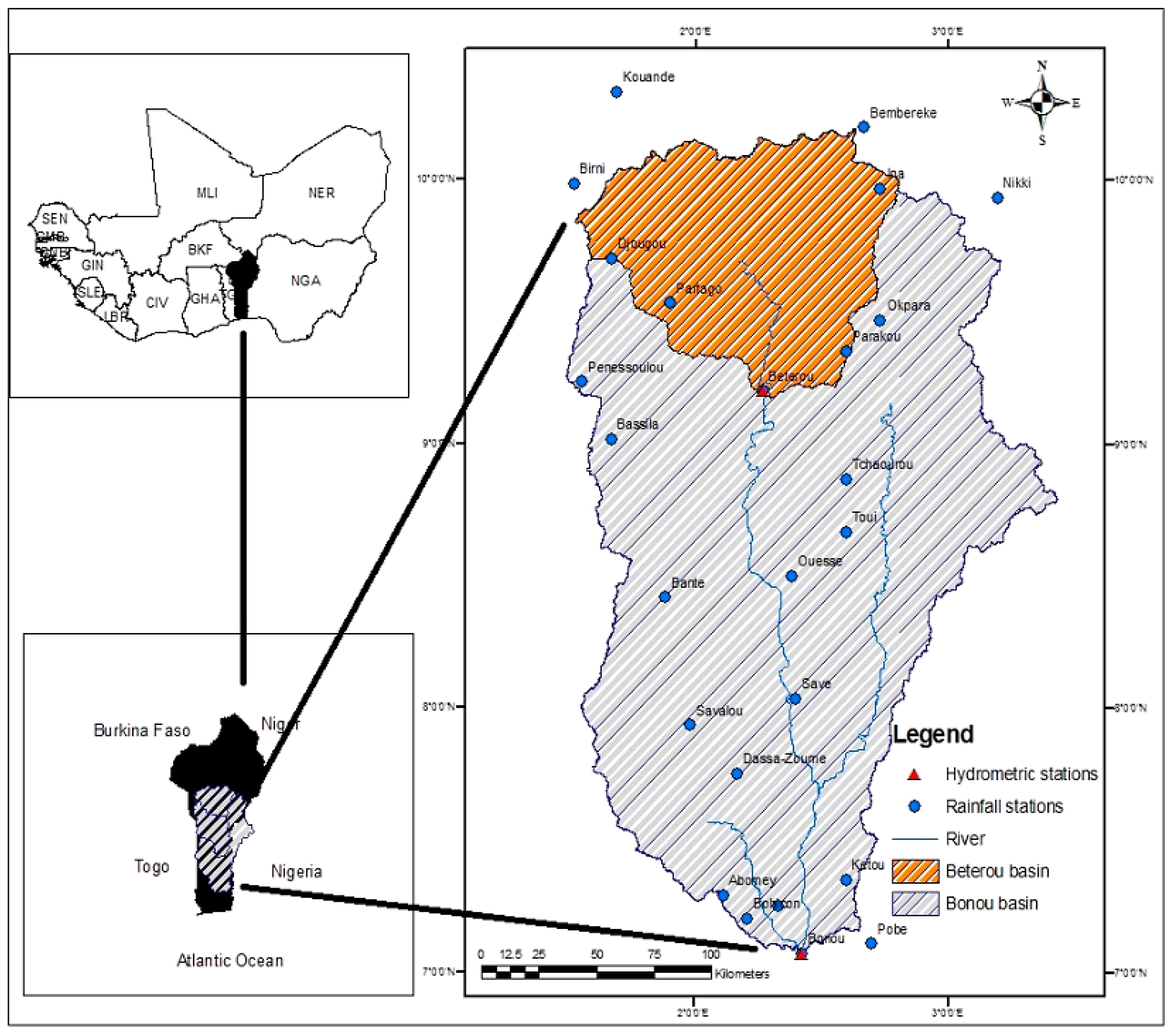

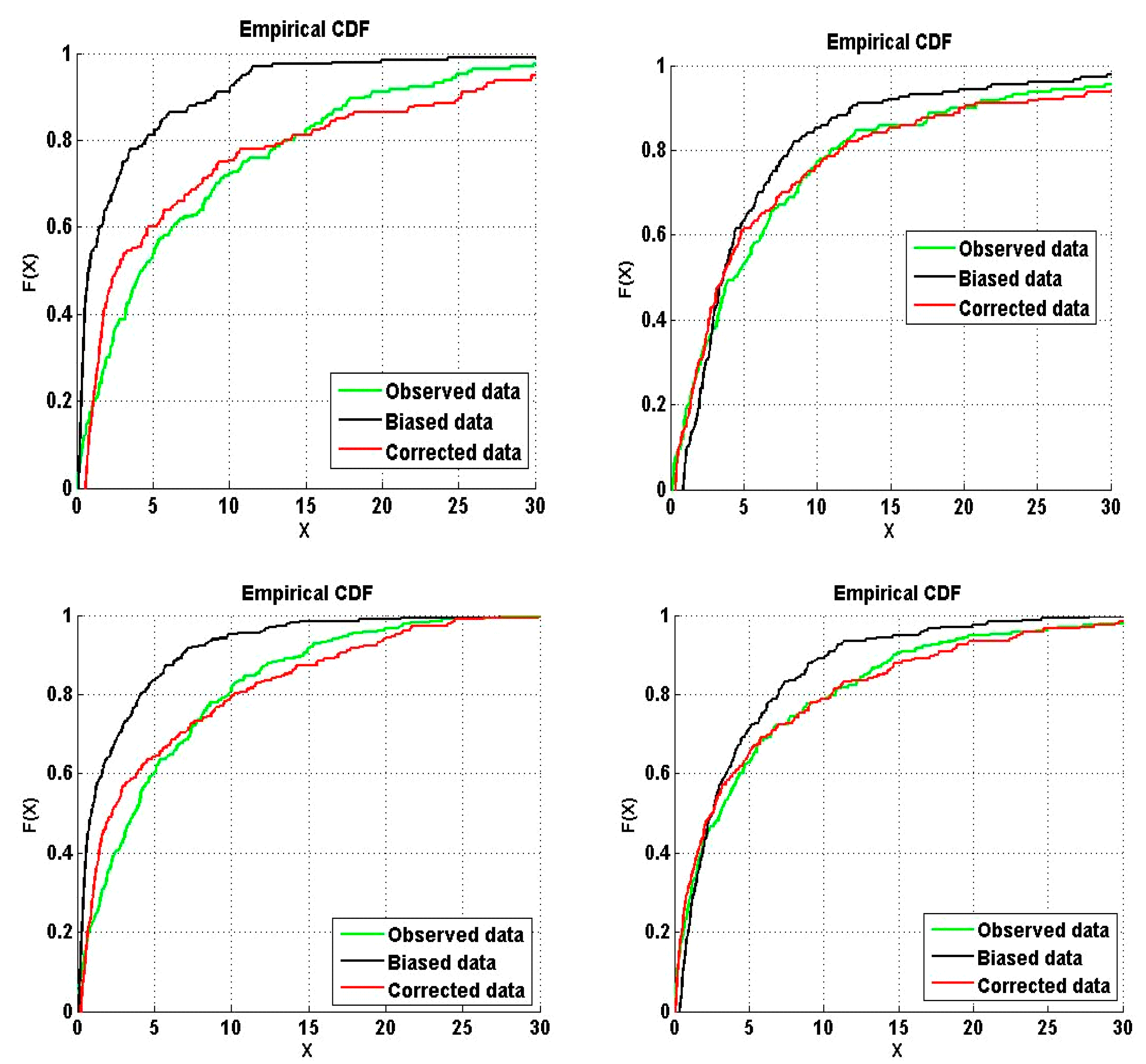
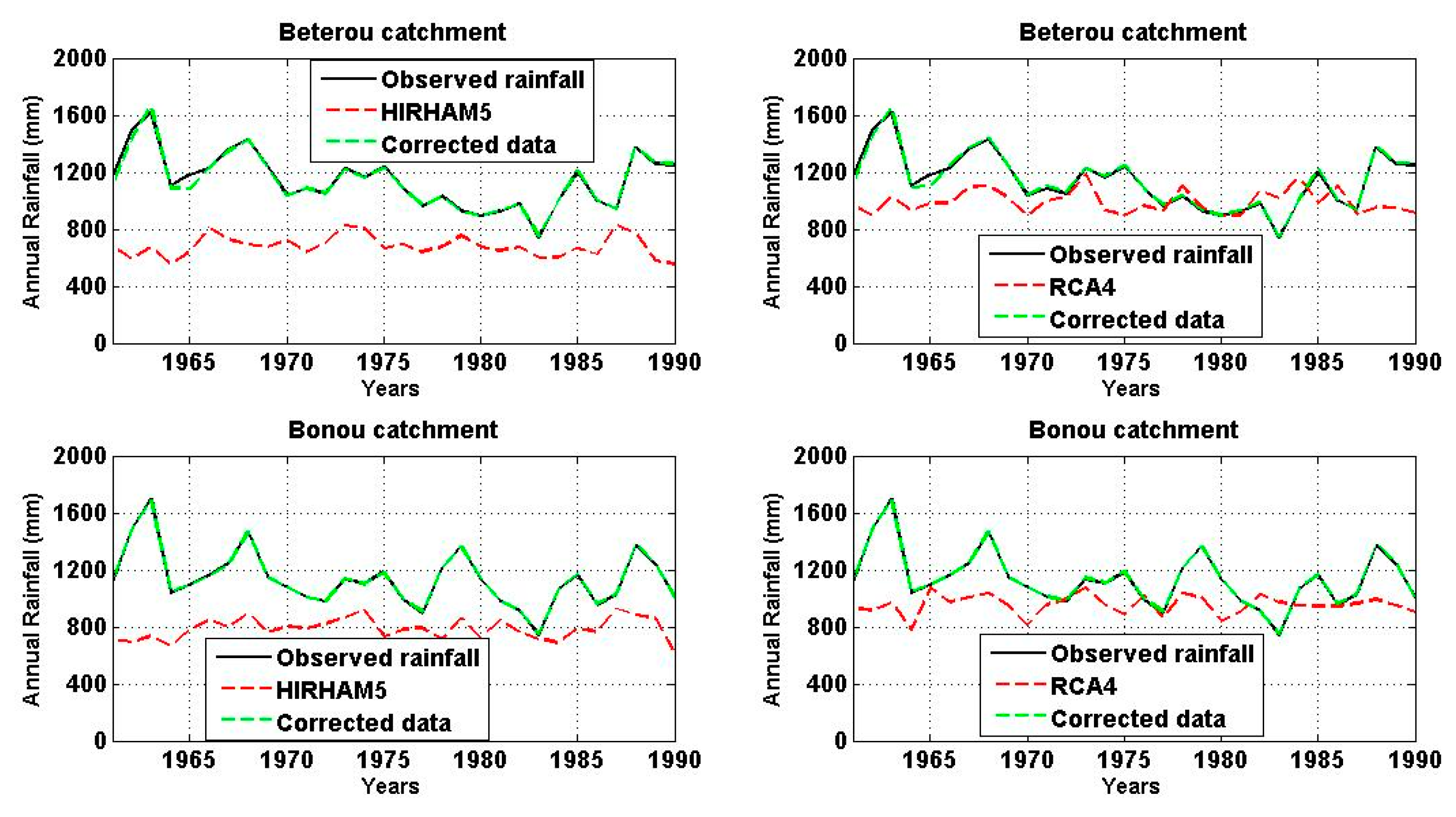

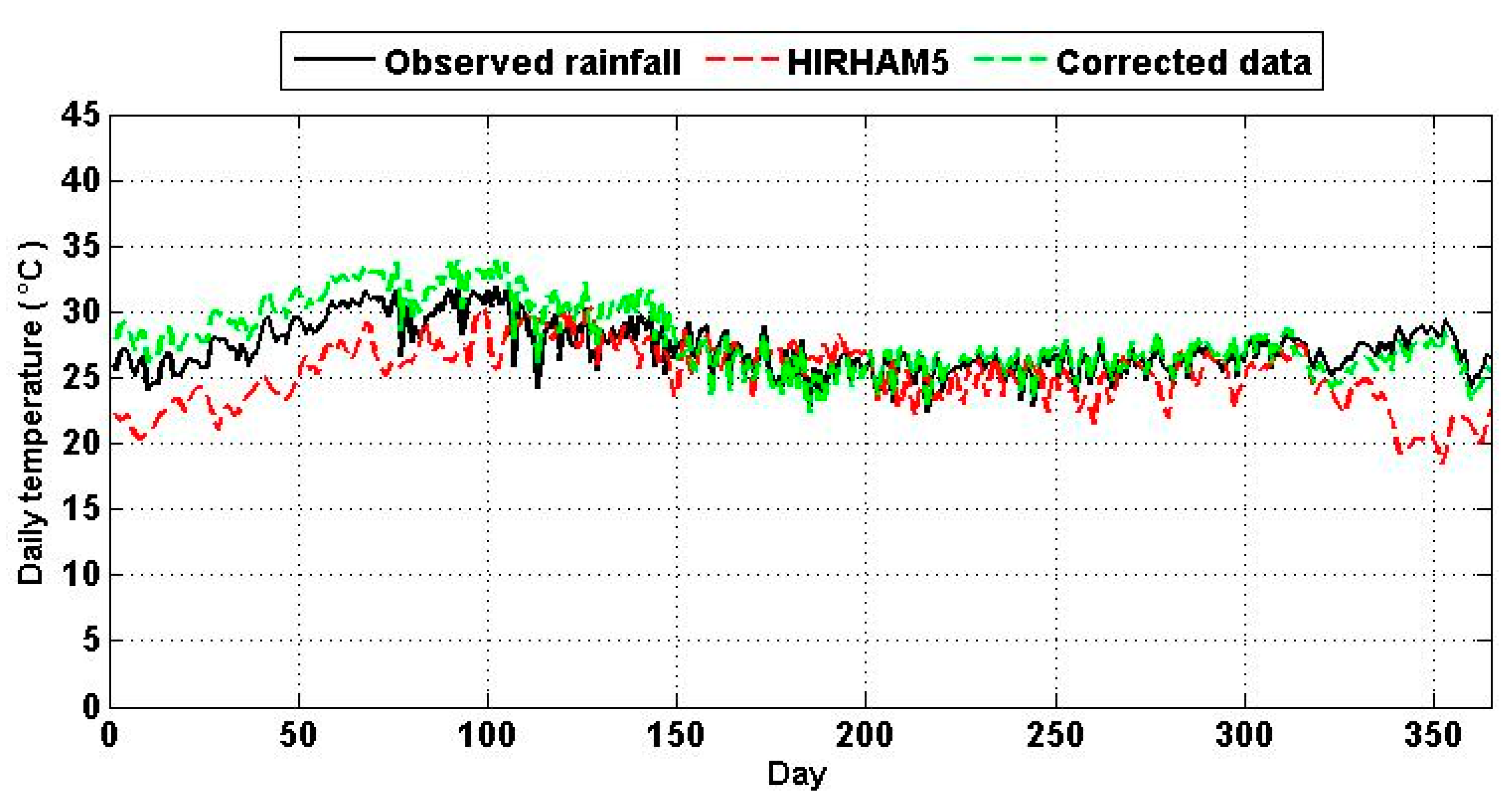

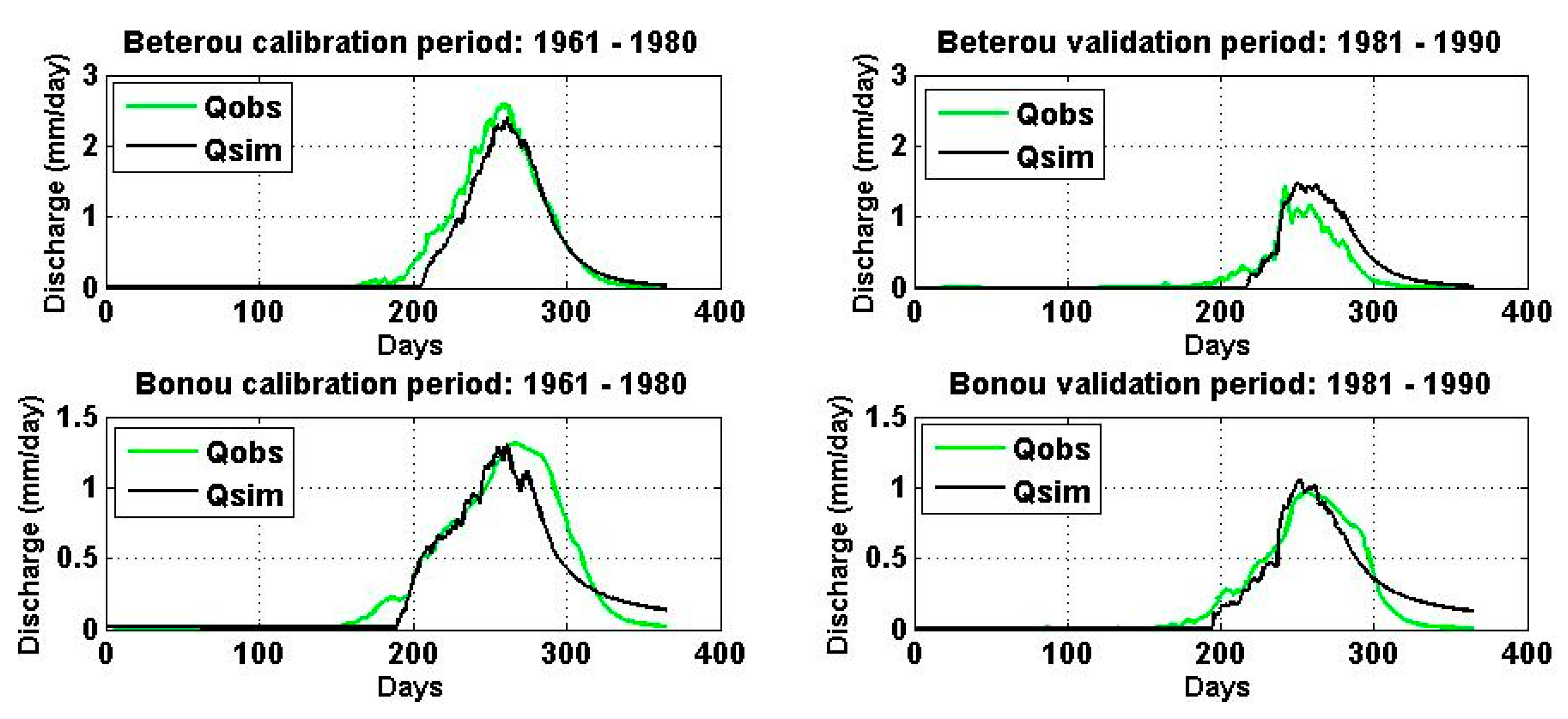
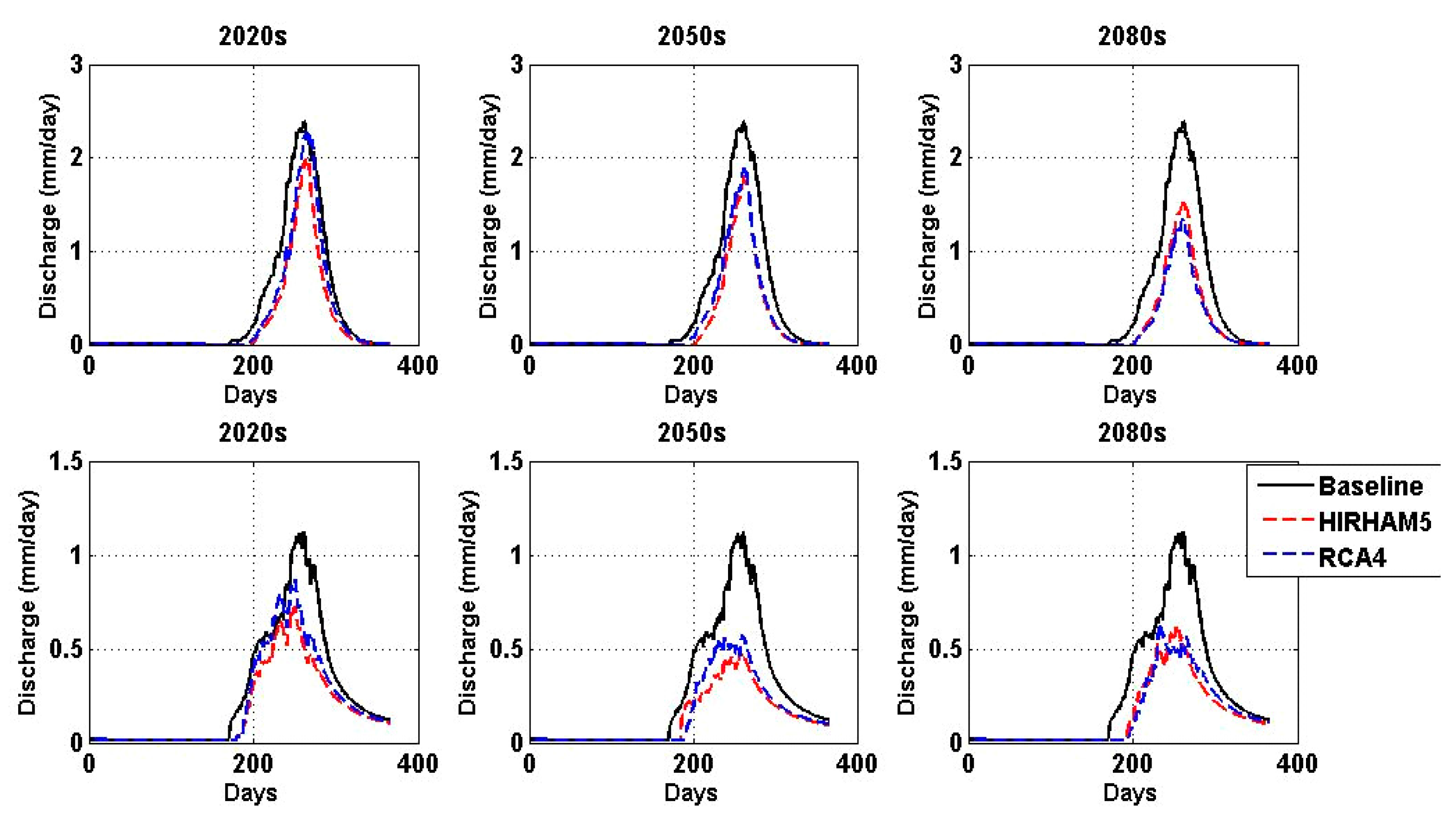
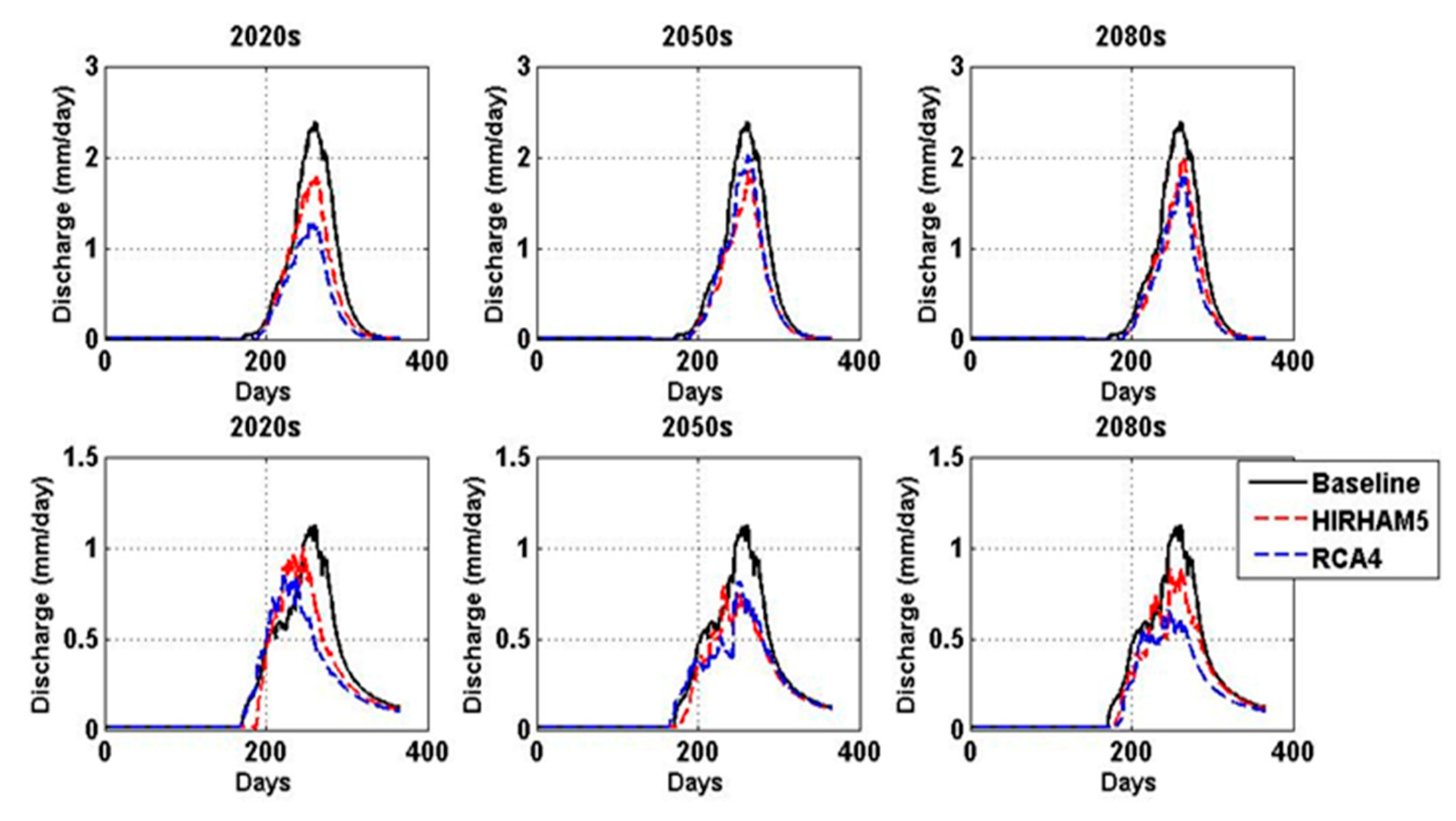

| Beterou | Bonou | |||||||
|---|---|---|---|---|---|---|---|---|
| HIRHAM5 | Corrected HIRHAM5 | RCA4 | Corrected RCA4 | HIRHAM5 | Corrected HIRHAM5 | RCA4 | Corrected RCA4 | |
| RMSE (mm/year) | 502.201 | 25.238 | 250.385 | 21.145 | 399.884 | 5.228 | 262.164 | 5.349 |
| MAE (mm/year) | 460.029 | 12.734 | 197.437 | 13.568 | 348.198 | 4.340 | 203.665 | 4.610 |
| Calibration | Validation | |||||
|---|---|---|---|---|---|---|
| CE | R2 | APB (%) | CE | R2 | APB (%) | |
| Bétérou | 0.93 | 0.93 | 13.05 | 0.76 | 0.87 | 39.1 |
| Bonou | 0.90 | 0.89 | 25.17 | 0.88 | 0.69 | 29.27 |
© 2017 by the author. Licensee MDPI, Basel, Switzerland. This article is an open access article distributed under the terms and conditions of the Creative Commons Attribution (CC BY) license (http://creativecommons.org/licenses/by/4.0/).
Share and Cite
Biao, E.I. Assessing the Impacts of Climate Change on River Discharge Dynamics in Oueme River Basin (Benin, West Africa). Hydrology 2017, 4, 47. https://doi.org/10.3390/hydrology4040047
Biao EI. Assessing the Impacts of Climate Change on River Discharge Dynamics in Oueme River Basin (Benin, West Africa). Hydrology. 2017; 4(4):47. https://doi.org/10.3390/hydrology4040047
Chicago/Turabian StyleBiao, Eliézer Iboukoun. 2017. "Assessing the Impacts of Climate Change on River Discharge Dynamics in Oueme River Basin (Benin, West Africa)" Hydrology 4, no. 4: 47. https://doi.org/10.3390/hydrology4040047




